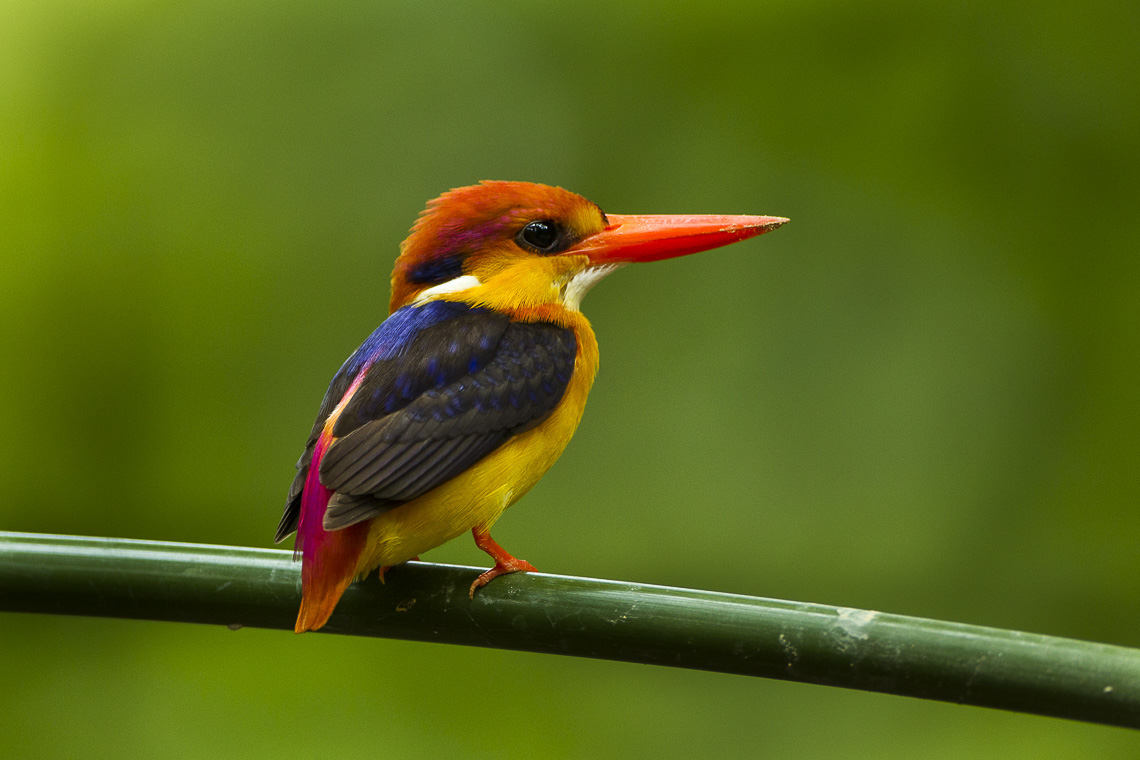Page snapshot: An overview of kingfisher feather color, how scientists study feather color, and how studying feather color helps us to understand kingfisher evolution.
Topics covered on this page: Introduction; Feather color in kingfishers; How scientists study feather color; What can scientists learn about kingfisher evolution by studying plumage?; Resources.
Credits: Funded by the National Science Foundation. Any opinions, findings, and conclusions or recommendations expressed in this material are those of the author(s) and do not necessarily reflect the views of the National Science Foundation.
Updates: Page last updated May 14, 2024.
Image above: A black-backed kingfisher (Ceyx erithaca) in Thailand showing its striking plumage. Photo by Francesco Veronesi (Wikimedia Commons, Creative Commons Attribution-ShareAlike 2.0 Generic license).
Introduction
Ornithologists (scientists who study birds) are interested in studying bird feather color and plumage patterns in order to describe birds, to understand their behavior, and to understand their evolution. In kingfishers, scientists are interested in investigating a number of questions, such as how kingfisher feathers get their color and how kingfisher feather color may be shaped by sexual selection, an evolutionary process driven by mate choice. Kingfishers also include groups of closely related species that live on islands. Scientists are interested in how their evolution on islands may have affected their plumage evolution when compared to species that live in mainland areas.

Forest kingfisher (Todiramphus macleayii), Karratha, Australia. Photo by Jim Bendon (flickr, Creative Commons Attribution-ShareAlike 2.0 Generic license, image cropped).
Feather colors in kingfishers
Kingfishers have striking plumages with sometimes complex patterns of color. Kingfisher colors come both from structures and from pigments. Blues, purples, and greens are structural. Melanin pigments give feathers black, gray, brown, reddish, and yellow colors. Carotenoid pigments yield purple, yellow, red, and orange feathers. Some blue kingfisher feathers also reflect light in the UV range.
Feather color might be best understood in the common kingfisher (Alcedo atthis), which is found in large parts of Europe and Asia. The common kingfisher has an orange breast with feathers that are colored by pigments and a blue back and tail with feathers that have structural color. The blue color is created by blue light that is reflected from the spongy internal structure of the feathers. Only the visible parts of the blue feathers reflect blue light; the parts of the feathers that are covered by other feathers as well as the undersides of the feathers appear gray.

Common kingfishers (Alcedo atthis) perched on a branch, Germany. Photo by Joefrei (Wikimedia Commons, Creative Commons Attribution-ShareAlike Unported license, image resized).
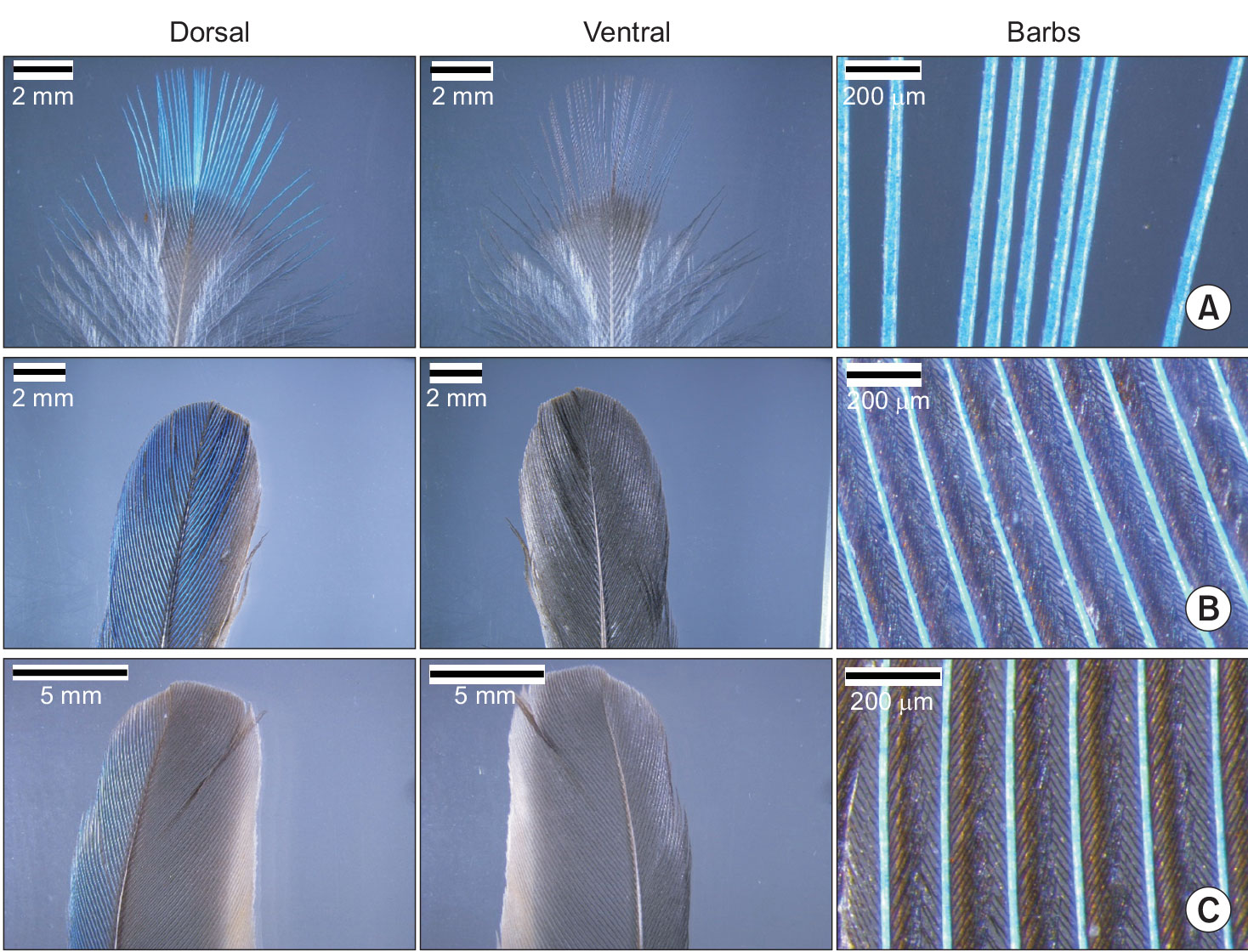
Blue feathers from the common kingfisher (Alcedo atthis) viewed under visible light. Top row (A): feathers from the bird's back; middle row (B): feathers from the bird's tail; bottom row (C): feathers from the bird's wing. Notice that the dorsal side of each feather (the outer side, left column) appears to be a different color than the ventral side of each feather (the inner side, middle column). The right column shows the feathers under magnification. The blue in these feathers are the result of structural color, not pigments. Figure 2 from Eunock et al. (2021) Proceedings of the National Institute of Ecology of the Republic of Korea (Creative Commons Attribution-NonCommercial 4.0 International license).
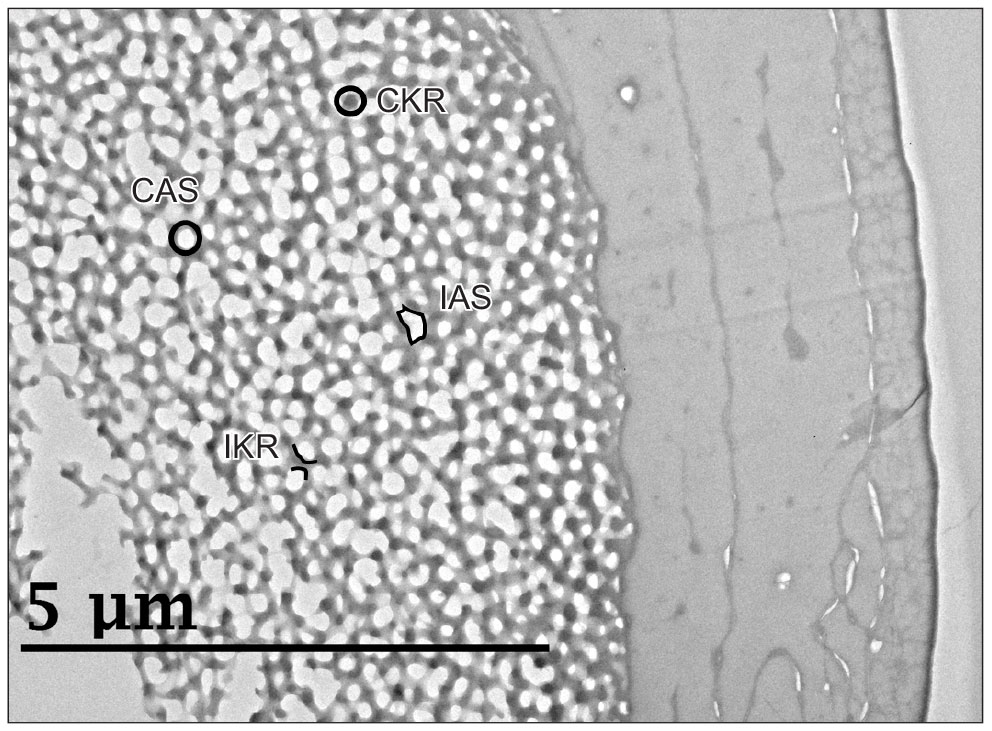
The microstructure of a blue common kingfisher (Alcedo atthis) feather. The feather's spongy core reflects blue light. Labels: CAS = circular air space; CKR = circular keratin rod; IAS = irregularly shaped air space; IKR = irregularly shaped keratin rod. Figure 1 from Eunock et al. (2021) Proceedings of the National Institute of Ecology of the Republic of Korea (Creative Commons Attribution-NonCommercial 4.0 International license).
How scientists study feather color
For some types of scientific studies, precise, repeatable observations of feather color are needed. Therefore, studying feather color is not as straightforward as having someone simply observe and describe the colors of a bird's feathers. Two people will not necessarily see or describe the feather colors of the same bird in the same way. Even when two people are using a reference book of color samples that they can compare to the colors of a bird's feathers, they will not necessary pick the same reference colors to describe the same feathers. Other factors, like the type of light used to observe or photograph a feather, can also affect its perceived color.
Instead of relying on researchers to subjectively describe plumage color, digital sensors called spectrometers can now be used to measure the wavelengths of light that are reflected by a bird's feathers, including UV light. Using these instruments, the colors of a bird's feathers can be sampled and recorded in a consistent and repeatable way. Spectrometers can also measure the wider color spectrum visible to birds and are good for measuring iridescent colors. Spectrometers are delicate instruments that are difficult to use in field settings. Therefore, museum collections are very important for spectrometer-based studies of color.
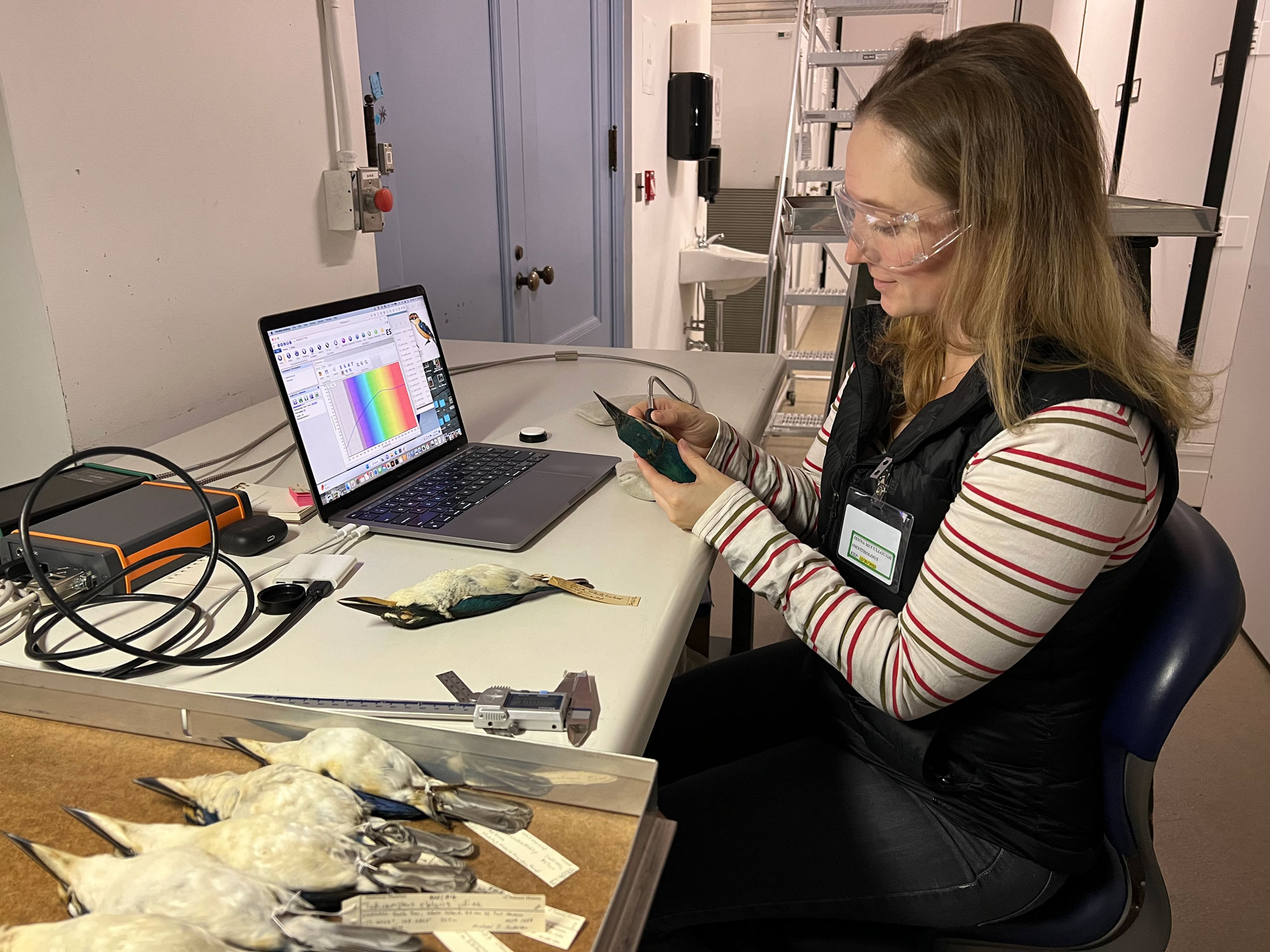
Scientist Jenna McCullough gathering data about plumage color of the collared kingfisher (Todiramphus chloris) using specimens held in a museum's collection. Photo courtesy of the project PIs (all rights reserved).
What can scientists learn about kingfisher evolution by studying plumage?
Scientists from the Field Museum in Chicago and the University of New Mexico in Albuquerque are researching what the feather colors and color patterns of kingfishers can tell us kingfisher evolution. In one study, they measured the feather colors of kingfisher specimens held in museum collections using spectrometers. They divided the kingfisher body into different patches and measured each bird's feather color in each patch. They then compared the colors and color patterns of different species of kingfishers to see what they had in common and how they differed.
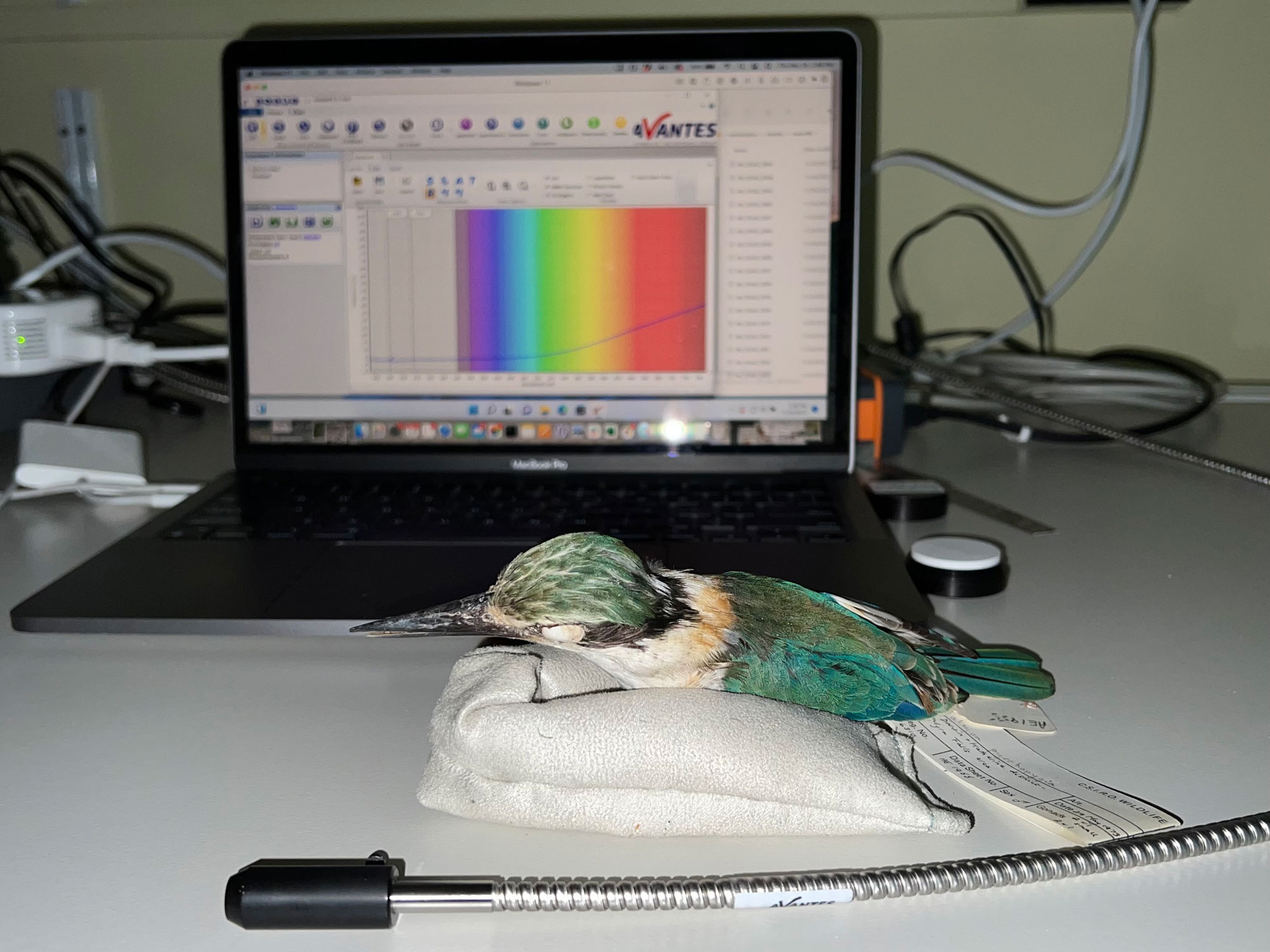
A preserved specimen of a red-backed kingfisher (Todiramphus pyrrhopygius) displayed with equipment for analyzing plumage color. Photo by the project PIs (all rights reserved).

Diagram of places where kingfisher feather color was sampled for a study of kingfisher plumage complexity and color evolution. Source: Graphic by Jenna McCullough, modified from Figure 1 in Eliason et al. (2023) eLife (Creative Commons Attribution 4.0 International license).
The scientists found that there was a greater variety of plumage on the backs of kingfishers than on their throats or bellies. They thought that the birds' backs showed more differences because they were easily seen by other birds. Thus, the colors on a kingfisher's back may be important in the process of choosing a mate. Sexual selection is the process in which mate choice drives the evolution of one or more characters in a species, in this case the plumage on a kingfisher's back.
The scientists also compared the colors and color patterns of kingfishers that live on islands to kingfishers that live in mainland areas. They found that feather color patterns were similar in complexity in mainland and island kingfishers. However, they also found that feather color evolves more quickly on islands than on continents.
Resources
Websites
Why does the kingfisher have blue feathers? (University of Cambridge Research): https://www.cam.ac.uk/research/features/why-does-the-kingfisher-have-blue-feathers
Articles & reports
Pérez-Rodríguez, L. 2013. La medición del color: técnicas y fundamentos para el estudio de la ecología de las aves [The measurement of color: techniques and foundations for the study of the ecology of birds]. Revista de Anillamiento 31-32: 4-20.
Scientific articles
Eliason, C.M., M.J. Andersen, and S.J. Hackett. 2019. Using historical biogeography models to study color pattern evolution. Systematic Biology 68: 755-766. https://doi.org/10.1093/sysbio/syz012
Eliason, C.M., J.M. McCullough, S.J. Hackett, M.J. Andersen. 2023. Complex plumages spur rapid color diversification in kingfishers (Aves: Alcedinidae). eLife 12: e83426. https://doi.org/10.7554/eLife.83426
Lee, E., H. Bae, D.-J. Jeon, S. Ji, J.-S. Yeo, and J. Kim. 2021. Microstructures in blue feathers of the common kingfisher. Proceedings of the National Institute of Ecology of the Republic of Korea 2: 21-25. https://doi.org/10.22920/PNIE.2021.2.1.21
Sela-Klein, D., Y. Lavner, and Y. Vortman. 2022. Breeding biology of the white-throated kingfisher Halcyon smyrnensis smyrnensis, with emphasis on color and vocalization. Journal of Ornithology 164: 151-161. https://doi.org/10.1007/s10336-022-02026-8
Stavenga, D.G., J. Tinbergen, H.L. Leertouwer, and B.D. Wilts. 2011. Kingfisher feathers-colouration by pigments, spongy nanonstructures and thin films. Journal of Experimental Biology 214: 3960-3967. https://doi.org/10.1242/jeb.062620



